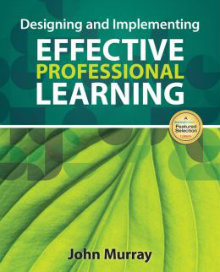A Concise Guide to Effective PD in Schools
Designing and Implementing Effective Professional Learning
By John Murray
(Corwin, 2014 – Learn more)

Designing and Implementing Effective Professional Learning by John Murray is as straightforward as an educational resource gets. There are no extra words. Wasting no time, the author and educational consultant starts the text by stating his purpose for writing it:
We expect our doctors to regularly evaluate and monitor our health and to select the best available plan for improvement – and we demand that they eliminate treatments that don’t work and replace them with more effective ones. But we rarely make the same demands of our schools and our teachers” (xiii).
To be able to make changes in our instruction, we need to have the tools and skills with which to improve. Murray provides many options in his resource.

► Context is the “why.” This concept encompasses many central ideas about professional learning, such as shared leadership, mission and vision, application of learning, and a focus on results.
► Content is the “what,” as in “What knowledge, skills, and dispositions are we to learn and incorporate into practice?”
► Process is the “how.” This involves the method(s) in which the content is applied within the context of the school.
Aligning all three concepts can improve professional learning, Murray contends. “The school leader must attend to the critical lenses of context, content, and process to create and sustain an effective teacher professional learning program” (61).
More about the book
The rest of the text focuses on the eight processes teacher teams, schools, and districts can adopt: lesson study, critical friends, school rounds, action research, mentoring, peer coaching, online professional development, and personal learning networks.
All of these options have common characteristics: They are relatively inexpensive, are largely embedded within the school day and context, and have a strong evidence base to support their effectiveness in improving teacher practice and student learning. Murray is not trying to sell you on a program or a consultant group. He provides a plethora of clear pathways for educators to take charge of their own learning.
There are many reasons to add this resource to your professional collection. First, Murray clearly knows his stuff. The recommendations he shares are based on the previous work of many great minds in the field. Second, the author considers his audience in his several suggestions for school improvement. Murray recognizes that each school is different. As I pointed out in the beginning of this review, the context for professional learning is given considerable weight. Finally, I appreciated the conciseness of the text. I would have no trouble in trying to find an idea I liked if I came back to the text.
A few reservations
There are a few areas in which I struggled while reading this resource. First, as much as I appreciated the brevity of Murray’s writing, I was also wishing for a little less theory and a bit more practice. His book would have benefited from more anecdotes about his experiences as both a practicing educator and a consultant.
Related, I also found myself searching for more of other educators’ personal positions on the practices he promotes. For example, do teachers prefer online professional learning over personal learning networks? Why or why not? There seemed to be an imbalance between the amount of research shared and what the implementation of these ideas might look like in practice.
Despite the few negatives, Designing and Implementing Effective Professional Learning deserves a place on any principal’s or curriculum director’s shelf. It is a resource that I will come back to as I work with our school leadership team to prepare for future professional learning.
This book would also make an excellent textbook selection for graduate school programs in educational administration. The breadth and depth of the topics covered by Murray give current and future school leaders an excellent foundation of what works when putting professional learning into practice.
Matt Renwick is a 16-year public educator who began as a 5th and 6th grade teacher in a rural school outside of Wisconsin Rapids, WI. After seven years of teaching, he served as a junior high dean of students, assistant principal and athletic director before becoming an elementary school leader in Wisconsin Rapids. Matt blogs at Reading by Example, tweets @ReadByExample and writes for EdTech magazine and other publications.
His first book, Digital Student Portfolios, is available at Amazon. And his new book from ASCD/Arias on technology myths in education will be published later this year.




































